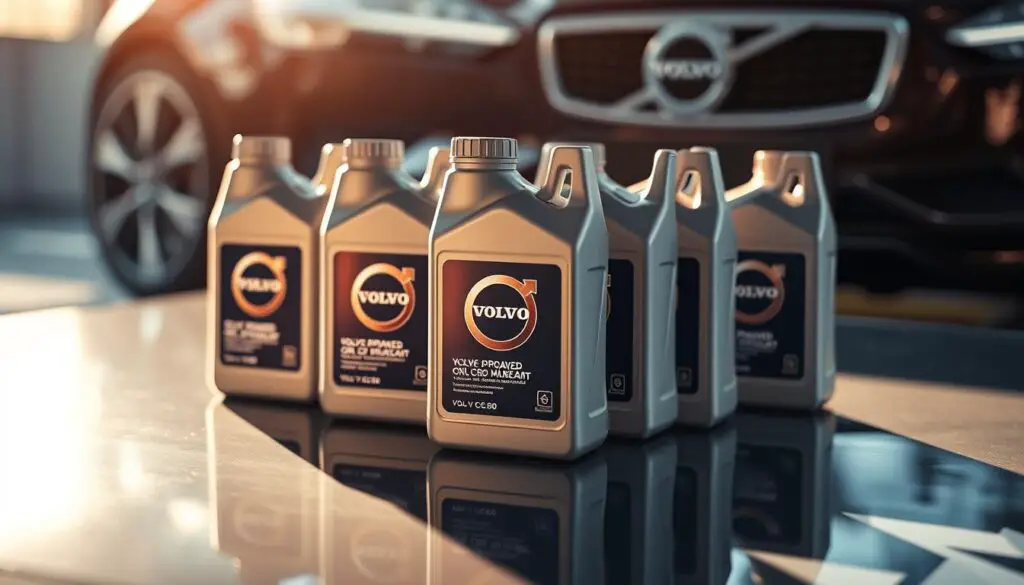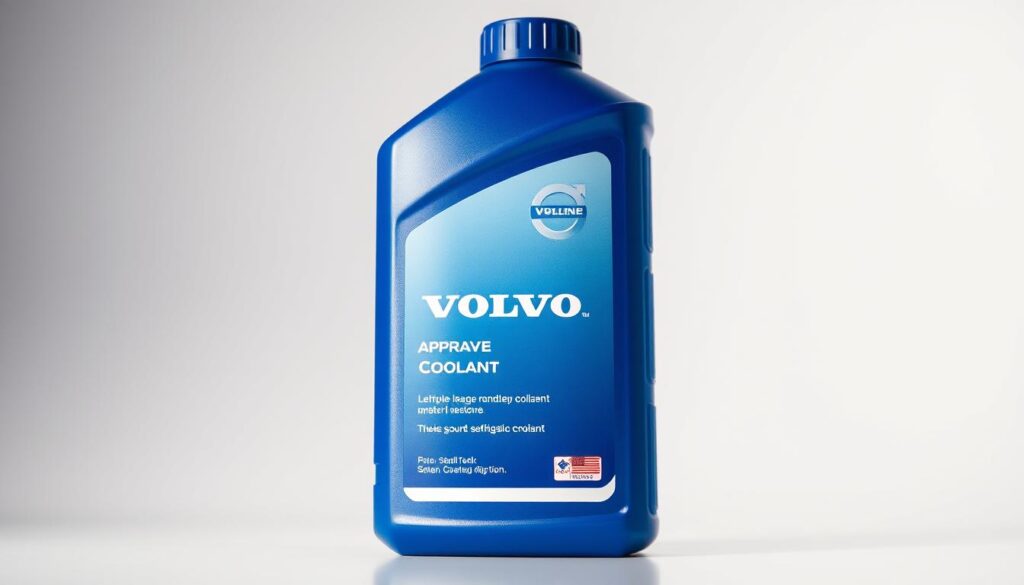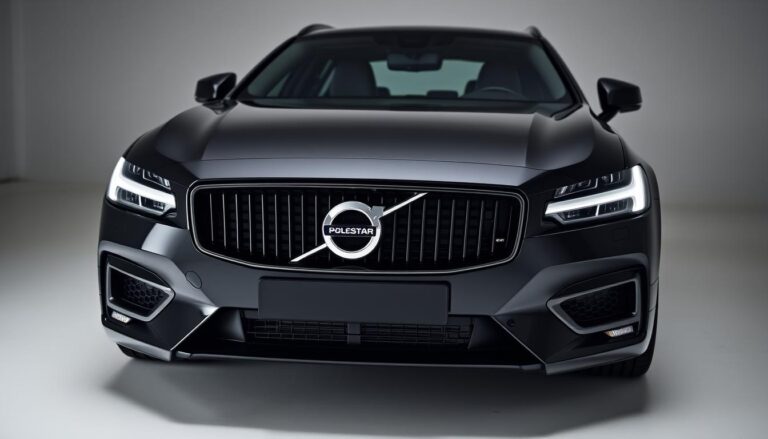Choosing the right coolant keeps engine temperatures steady and protects aluminum parts from damage. Volvo-approved fluids undergo strict testing for anti-wear performance, high heat transfer, and compatibility with light alloys.
These formulas avoid nitrates, amines, and phosphates and are made to leave no deposits. That reduces the risk of corrosion and helps the cooling system last longer.
For many XC60 models, SI-HOAT blends suit 2010–2016 cars, while 2017 and later often call for yellow pre-mix options like Prestone AF2850. Using the wrong fluid or mixing types can cause failures, downtime, and costly repairs.
This guide will help you spot authentic labels, match chemistry to your model, and follow proper water and fill practices that prevent scaling and hotspots. When shopping in the parts aisle in the United States, look for clear alignment with Volvo’s chemistry and testing claims.
Key Takeaways
- Volvo-approved fluids are tested for anti-wear and material compatibility.
- Choose SI-HOAT for 2010–2016 XC60; yellow pre-mix for 2017+ models like Prestone AF2850.
- Avoid mixing different formulas to reduce corrosion and service risks.
- Correct water and fill practices prevent scaling and preserve cooling performance.
- Labels that list no nitrates, amines, or phosphates signal authentic chemistry.
Buyer’s Guide Overview: Choosing the Right Coolant for Volvo Engines Today
Picking the correct fluid for a modern engine starts with chemistry, not color. Match formulas to model year and materials to avoid corrosion and deposits.
Quick shopping strategy at the auto parts store:
- Confirm model-year fitment — many 2010–2016 cars pair with SI-HOAT-style mixes; 2017+ often call for yellow pre-mix options.
- Check additive tech and documented compatibility instead of relying on bottle hue.
- Choose pre-mix for easy fill, or concentrate if you control water quality with high-purity water.
Routine upkeep matters: inspect the reservoir when the engine is cool, keep level between Min and Max, and replace fluid about every 50,000 miles or 5 years.
Why this matters: top-tier products tested for corrosion protection preserve pump life, heater cores, and radiator efficiency. Keep a shortlist of approved products on your phone to save time in the aisle and avoid mixing incompatible coolants. click expand for deeper chemistry and interval details.
What “Volvo Approved” Really Means for Your Cooling System
Approval means the fluid proved its corrosion and wear protection in Volvo test engines. That certification reflects lab and real-world trials focused on long-term material compatibility and heat transfer.
Rigorously tested by Volvo engineers
Volvo-approved products are evaluated for anti-wear performance, seal safety, and resistance to deposits. Tests confirm the product won’t attack aluminum, plastics, or gaskets used in modern engines.
P-HOAT and SI-HOAT chemistry
These hybrid blends use acid technology and OAT inhibitors plus targeted hybrid additives. The result is long-life protection for mixed-metal systems and a stable inhibitor film that fights corrosion and scale.
Ethylene vs. propylene glycol
A quick comparison shows trade-offs in heat transfer and toxicity. See the table for a concise view.
| Base | Heat Transfer | Toxicity |
|---|---|---|
| Ethylene glycol | Higher | Higher |
| Propylene glycol | Slightly lower | Lower |
Approved specs vs. “universal” claims
Many generic coolants promise broad fitment, but they may not prove no-deposit performance or metal compatibility in Volvo engines. Certified fluids explicitly avoid nitrates, amines, and phosphates to protect water pumps and narrow passages.
At the parts store, read the label for inhibitor type, model-year fitment, and Volvo language. Avoid mixing different products to keep the system stable.
Click expand for detailed data on hybrid lifecycles, inhibitor chemistry, and how approval links to warranty and uptime.
Model Fitment Essentials: Coolant Types That Work for Volvo XC60 by Year
Start shopping by identifying your XC60 year, then confirm the required inhibitor type on the label. That simple step cuts the risk of mixing incompatible products at the auto parts shelf.

2010–2016 XC60
Owners from these years should seek SI-HOAT-focused fluids. Those formulas were tested for mixed-metal engines and are what most service guides list for this range.
Some bottles may look different in hue, so color is not a spec. Scan labels for SI-HOAT or hybrid inhibitor language instead of relying on green coolant or other tints.
2017–present XC60
Later models commonly use yellow pre-mix options such as Prestone AF2850 or vetted universal yellow concentrates like ShopPro.
Verify that the concentrate or pre-mix states hybrid or HOAT compatibility for your model years before buying.
How to read labels at the auto parts store
Look for OAT/HOAT/P-HOAT notations and explicit fitment notes. If a bottle references japanese cars or asian coolant applications, check the inhibitor system carefully.
Avoid mixing a leftover jug from another vehicle—mixing types can destabilize inhibitors and cause corrosion or deposits.
- Quick tip: bring your manual or VIN range to match coolant types fast at the parts counter.
- Click expand for a compatibility chart and label examples to save time next visit.
Best Volvo Approved Coolant: How to Identify Authentic Quality at the Parts Store
A five-second label audit at the auto parts store separates genuine chemistry from marketing color.
Start by scanning for Volvo wording and hybrid inhibitor names. These claims show the product matches the engine materials and service intent.
Label checkpoints
What to look for: P-HOAT, SI-HOAT, or OAT callouts and a clear statement of no nitrates, amines, phosphates. That wording signals tested corrosion protection and anti-wear performance.
Also confirm listed fitment, documented service intervals, and any mention of acid technology. If a bottle lacks specifics, leave it on the shelf.
Pre-mix vs. concentrate: system fill and water quality
Pre-mix simplifies a clean system fill and removes dilution guesswork. It is ideal when you want a direct top-up with known water content.
Concentrates let you control water quality. Use distilled water for mixing to avoid mineral scaling that harms pumps and narrow passages.

Color is not a spec
Green coolant or other tints can look like what you have but mean different chemistry. Products marketed as asian coolant may look similar yet use incompatible inhibitors.
Always confirm inhibitor type first, then match vehicle fitment. A quick shelf test: verify additive tech, check fitment, then confirm service guidance before buying.
| Choice | Ease | Water Control | When to use |
|---|---|---|---|
| Pre-mix | Very easy | Factory-controlled | Fast top-ups and uncertain water quality |
| Concentrate | Requires mixing | Use distilled water for best results | Full service or when you control water purity |
| Shelf label check | Quick audit | Not applicable | Confirm P-HOAT/SI-HOAT, no nitrates/amines/phosphates |
Practical tip: save a photo of the bottle on your phone so future purchases match what’s already in the cooling system. Click expand for side-by-side label examples and keep your engine protected with the right chemistry, not just matching color.
Maintenance That Protects Your Engine and Wallet
Keeping a routine maintenance plan for the cooling circuit saves money and avoids downtime. Small checks and timed services refresh inhibitors and preserve heat transfer across the engine.
Intervals and schedule
Plan to change coolant about every 50,000 miles or five years. That timing refreshes protection and reduces the chance of corrosion, pump wear, and scale.
Check the reservoir and top up safely
When the engine is cold, inspect the coolant reservoir. Keep the level between Min and Max and top only with the same product to avoid mixing types. Watch for low coolant, residues at hose connections, or a sweet smell under the hood.
System flush basics
For a proper system flush, drain the old coolant, rinse with distilled water until clear, then refill with the correct fluid and dilution. High-purity water prevents mineral scale and protects the water pump and heater core.
Proper disposal
Used fluid is hazardous. Take old coolant to a recycling center or an auto parts store that accepts it — never pour it down drains. Click expand for a step-by-step checklist and bleed tips.
Common Pitfalls: Mixing, Corrosion, and Compatibility Risks
Mixing different inhibitor chemistries can undo protection and speed up metal attack inside the cooling circuit. That reaction often neutralizes the protective film on aluminum and other alloys.
How incompatible blends cause trouble
When coolants with different inhibitor packages mix, they can form gel-like deposits. These gels restrict flow and trap corrosion byproducts.
Deposits reduce water cooling efficiency. That leads to hotspots, sensor errors, and extra wear on the thermostat and radiator.
Mixing glycols and early-warning signs
Even similar-looking products may use ethylene glycol or propylene glycol bases with different additives. Blending them without guidance can compromise protection and stability over time.
- Watch for: persistent low coolant and intermittent overheating.
- Sweet smells from the engine bay or discolored, rusty, or oily fluid indicate contamination or internal leaks.
- Operating with poor chemistry speeds gasket and seal failures and raises repair costs.
Action: fully drain and flush a contaminated system, clean corrosion byproducts, then refill with a single approved product to restore predictable inhibitor performance. For a detailed troubleshooting flow, click expand.
Conclusion
A clear checklist at the end helps you choose the right fluid and keep the cooling system healthy.
Match the fluid to your XC60 year, favor proven acid technology and verified inhibitor packages, and ignore green coolant color as the sole guide. Volvo-approved products were tested for anti-wear and deposit-free service, so verify label fitment before buying at the auto parts counter.
Plan to change coolant around 50,000 miles or five years, flush with distilled water during a system flush, and use distilled water for any mix to protect the water pump and heater core. Remember: ethylene glycol gives stronger heat transfer; propylene glycol lowers toxicity — pick the chemistry that fits the system.
Quick checklist: read the label, confirm inhibitor type, perform a clean system fill, save your top coolant part number, and ask about disposal when you purchase. For step-by-step guidance, click expand.
FAQ
What does “Volvo approved” mean for a coolant?
“Volvo approved” indicates the coolant passed Volvo’s tests for corrosion protection, seal compatibility, and additive stability. It typically meets OAT/HOAT or P-HOAT chemistries Volvo specifies, protects aluminum components, and helps maintain warranty and long-term uptime.
Can I mix different coolant types like OAT, HOAT, or traditional green antifreeze?
No. Mixing different chemistries—OAT, HOAT, or old-school green formulations—can neutralize inhibitors, speed corrosion, and form deposits. Always match the coolant type already in the system or perform a full flush and refill with the correct chemistry.
Is ethylene glycol better than propylene glycol for Volvo engines?
Ethylene glycol offers slightly better heat transfer and is the most common base in OEM-spec coolants. Propylene glycol is less toxic but may not match Volvo’s performance specs. Follow Volvo’s recommended formulation rather than choosing by base alone.
How often should I change the coolant in a Volvo?
Change coolant roughly every 50,000 miles or every five years, whichever comes first. Severe conditions or signs of contamination warrant earlier replacement. Use the approved type and follow correct flush and refill procedures.
Should I use pre-mix coolant or concentrate plus distilled water?
Pre-mix saves time and ensures correct freeze/boil protection. Concentrate plus distilled water allows precise control of concentration and is preferred if you need exact antifreeze strength. Never use tap water—it increases corrosion risk.
My coolant is yellow — does color indicate compatibility?
Color is a manufacturer choice, not a performance spec. Yellow coolant can be correct for many modern Volvos, but color alone doesn’t confirm compatibility. Always check labels for OAT/HOAT chemistry and Volvo approval wording.
What are the signs of coolant problems I should watch for?
Watch for overheating, low coolant level, a sweet smell in the cabin, rusty or oily-looking fluid, and white sludge. These indicate leaks, contamination, or failed inhibitors and need prompt inspection.
Can I top off low coolant at home without flushing the system?
You can top off with the same chemistry and concentration if levels are only slightly low. Do not add a different type. If the existing coolant is unknown or contaminated, schedule a flush and refill with the correct fluid and distilled water.
How do I perform a basic coolant system flush and refill?
Drain the old coolant, flush the system with distilled water until clear, then refill with the recommended concentrate diluted to the specified ratio or with the approved pre-mix. Bleed air from the system per the service manual to avoid hotspots.
Where can I safely dispose of old coolant?
Take used coolant to an auto parts store, municipal hazardous-waste center, or recycling facility. Do not pour it down drains or on the ground—ethylene glycol is toxic to people and wildlife.
Are there model-specific coolant requirements for XC60 by year?
Yes. Older XC60s (2010–2016) often use SI‑HOAT-style formulations, while 2017 and newer models typically use yellow pre-mix or approved HOAT concentrates. Always check the owner’s manual or parts-store label for year-specific fitment.
Will using a generic “universal” coolant harm my warranty?
Using a coolant that doesn’t meet Volvo’s approved specs can risk warranty coverage for related failures. Choose products stating Volvo approval or matching the exact OAT/HOAT/P‑HOAT spec required for your model year.
How does corrosion form when coolants are mixed or old?
Mixing chemistries neutralizes corrosion inhibitors and can create acidic byproducts. Old coolant loses inhibitor effectiveness over time. Both scenarios accelerate pitting and scale formation, damaging aluminum heads, the water pump, and the radiator.
Can I use automotive antifreeze labeled for Japanese or Asian cars in my Volvo?
Only if the label states compatibility with Volvo’s required chemistry or lists Volvo approval. Some Asian-branded coolants use different additive packages unsuitable for Volvo engines; rely on the spec, not the brand origin.
What checklist should I use at the auto parts store to identify authentic quality coolant?
Look for explicit Volvo-approved wording or part numbers, OAT/HOAT or P‑HOAT additive tech, “no nitrates, amines, phosphates” statements, and clear instructions for dilution. Avoid choices that rely solely on color or “universal” claims.



